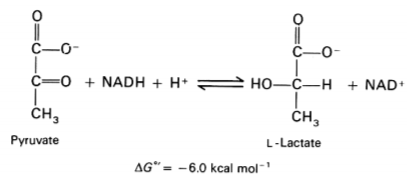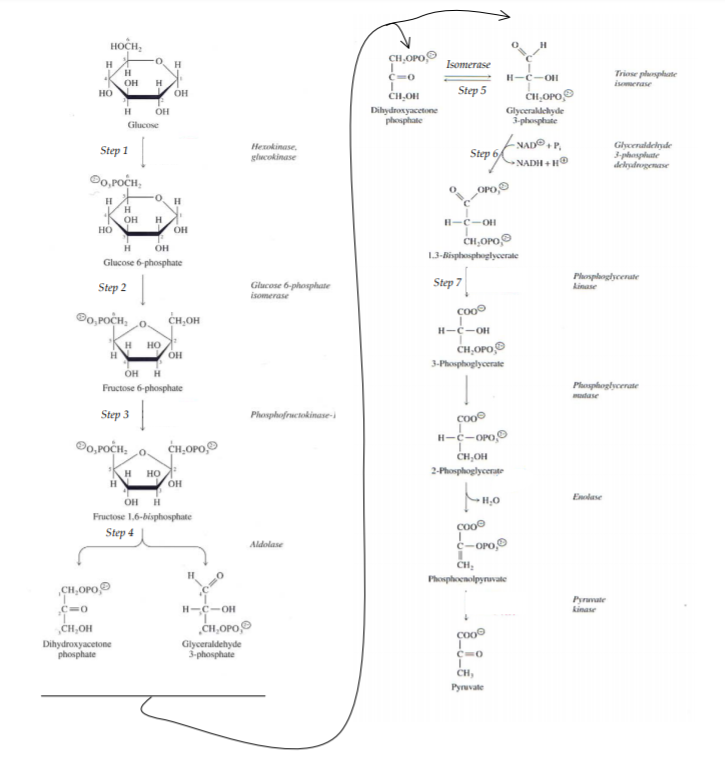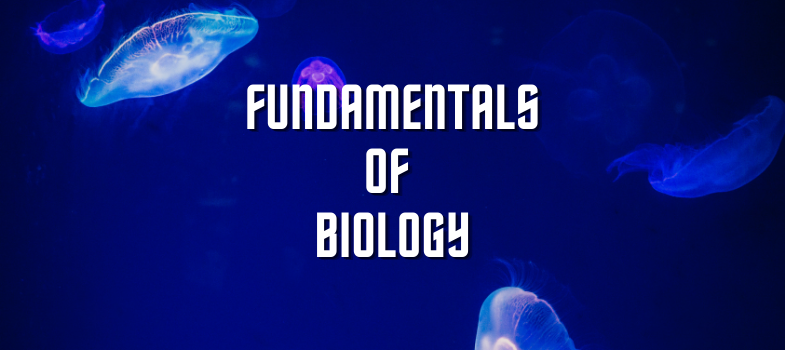Practice Problems Answer Key
Only open this once you've completed the assignment.
All correct answers are in red text.
Practice Problems for Biochemistry, Session 6: Glycolysis, Respiration and Fermentation
REFER TO THE PHOTO AT THE BOTTOM OF THIS ASSIGNMENT WHEN NECESSARY!
Question 1
Glycolysis can be summarized as: 
a) In a yeast cell, what is the fate of the carbon in pyruvate under anaerobic conditions?
ethanol
b) In a yeast cell, what is the fate of the carbon in pyruvate under aerobic conditions?
CO2
c) In step 7 of glycolysis 1,3-Bisphosphoglycerate (BPG) is converted into 3-Phosphoglycerate (3PG). Which of these molecules, BPG or 3PG would you expect is at a higher energy level? Explain your answer.
BPG is at a higher energy level than 3PG. You can infer this because BPG has two phosphate groups as
compare to 3PG, which has one phosphate group. Also, the conversion of BPG into 3PG drives the synthesis of
ATP.
d) The enzyme triose phosphate isomerase, catalyzes step 5. In this step Dihydroxyacetone phosphate is converted into Glyceraldehyde-3-phosphate (DAP ←→G3P). Glyceraldehyde-3-phosphate (G3P) is immediately used in step 6. Dihydroxyacetone phosphate must be converted to Glyceraldehyde-3-phosphate (G3P) before it can continue through glycolysis. Cells lacking triose phosphate isomerase can’t convert (DAP←→G3P). These cells can remain alive but only under aerobic conditions. Explain why cells lacking triose phosphate isomerase are alive only under aerobic conditions.
Cells that lack triose phosphate isomerase can complete glycolysis using only G3P, but this generates only 2 ATP. In
these cells under anaerobic conditions there is no net gain of ATP from glycolysis. Under aerobic conditions, the
single pyruvate can be further oxidized to generate a little more ATP and the energy stored in NADH can be
harvested through oxidation phosphorylation to generate even more ATP.
e) Assume that you have a cell that is able to complete glycolysis, the citric acid cycle, and the steps of oxidative phosphorylation involving the electron transport chain. However, the ATP synthase in this cell allows passage of H+ ions but does not produce ATP. When grown in aerobic conditions, you expect this cell to generate…
(circle the best answer from below)
- the same amount of ATP as a cell that was fermenting.
- a little more ATP than a cell that was fermenting.
- a little less ATP than a cell that was fermenting.
- about the same amount of ATP as a cell that was respiring normally under aerobic conditions.
Explain your choice.
Only little more ATP is generated when pyruvate is used in the citric acid cycle. The bulk of the ATP which is
produced in oxidative phosphorylation will not be recovered.
f) Assume that you have a cell that completes glycolysis, the citric acid cycle, and the first steps of oxidative phosphorylation normally. However, in this cell you inhibit the transfer of electrons to the last protein in the electron transport chain. Explain why glycolysis in this cell stops almost immediately, even before all of the ATP is depleted.
NAD+
is required as an electron carrier for glycolysis and must be regenerated from NADH. In respiration, NADH
transfers electrons to the first protein in the electron transport chain, and these electrons move through the chain
and are ultimately transferred to oxygen. If the transfer of electrons is halted, then all of the carriers will be
holding electrons and NADH will be unable to transfer electrons. This will prevent the regeneration of NAD+
, so
glycolysis stops.
Question 2
In the 1860's, Louis Pasteur observed the following phenomenon, which has come to be called "the Pasteur Effect". If you grow a culture of E. coli bacteria (which can grow anaerobically or aerobically) without O2, they consume large amounts of glucose as they grow and they produce lactic acid from the glucose. If you now supply this culture with O2, you make two observations:
1) Lactic acid is no longer produced.
2) The rate of glucose consumption (glycolysis) decreases even though the rate of cell growth is constant.
a) Explain both of these results in terms of fermentation and respiration.
In the absence of O2, pyruvate is fermented into lactic acid as a means to regenerate NAD+, however, only 2 ATP
are produced per glucose molecule. In the presence of O2, pyruvate enters the Citric Acid Cycle (CAC) which
produces additional ATP and NADH. The NADH from glycolysis and the CAC unload electrons to the electron
transport chain which can produce additional ATP. Because respiration (the CAC + oxidative phosphorylation)
produces 18x more ATP/glucose, less glucose is consumed.
b) Fermentation is one example of a pathway by which the electron carrier used in glycolysis is regenerated. Draw the appropriate structures of the reactants and the products of fermentation in the boxes below. (MUST HAVE THE DRAWING BELOW)

c) Where does the oxidative phosphorylation in E. coli cells take place compared to a eukaryotic cell?
In E.coli, oxidative phosphorylation takes place on the plasma membrane. In eukaryotes, oxidative
phosphorylation takes place on the inner mitochondrial membrane.

